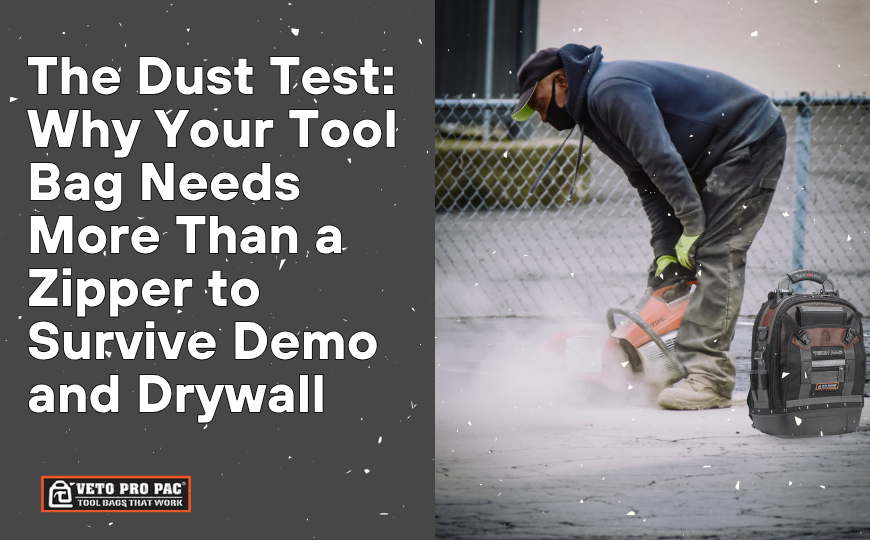I still remember the day my Fluke 87V died on me. I was in a crawl space under a 1970s ranch house, elbow-deep in knob-and-tube wiring, when the meter started throwing random voltage readings. A quick wipe-down revealed a thin gray film inside the case, drywall dust that had snuck past a $12 zipper on my open-top tote. That meter cost me $450 to replace. The tote? Maybe $35. Lesson learned the hard way: dust is the silent killer of precision tools, and most bags are wide-open doors.
If you’re a plumber, electrician, HVAC tech, or remodeler who works around demo, drywall, or concrete, you’ve seen it: white haze on your Klein pliers, grit in your ratchet, or a multimeter that ghosts you mid-job. This isn’t just annoying—it’s expensive. Let’s break down exactly how fine particulates wreck your gear, why standard zippers are a joke in these environments, and what actually works. I’ve pressure-tested bags in real attics and basements for years; here’s the no-BS version.
1. The Invisible Enemy: How Fine Dust Actually Kills Tools
Dust isn’t “dirt.” It’s a mix of crystalline silica (from concrete), gypsum (drywall), cellulose (insulation), and metal oxides. Particle sizes range from 0.5 to 10 microns—smaller than smoke. That’s small enough to float for hours and infiltrate everything.
- Abrasion: Silica rates 7 on the Mohs hardness scale—harder than the steel in your screwdriver tips. Once inside a moving joint, it grinds away metal with every cycle. I’ve seen a Snap-on 3/8″ ratchet develop 0.010″ of slop in six months of drywall work because dust packed the pawls.
- Conductivity: Drywall dust + humidity = conductive paste. A single layer on a PCB trace can bridge solder joints. Fluke’s own service bulletins cite dust contamination as the #1 cause of intermittent failures in the 87/89 series. Blowing it out with canned air? Good luck—compressed air just drives particles deeper.
- Binding: Gypsum absorbs moisture from the air and hardens. Mix it with zipper lube and you get literal cement in the coils. I once had to cut a zipper off a bag with side-cutters because it fused solid after a single demo shift.
2. Zipper Failure: Why “Heavy-Duty” Is a Lie
Most tool bags use #5 or #8 coil zippers. They’re fine for gym clothes. In demo dust? They’re toast.
The Grinding Compound Effect
Every time you zip, dust trapped in the coils acts like valve lapping compound. The teeth wear asymmetrically, creating gaps. Eventually, the slider skips teeth and the zipper blows open under load—usually when the bag is full of $2,000 worth of meters.
3. The Shell: Materials That Actually Block Dust
Hold your bag up to a work light. See pinholes? Dust laughs at those.
PVC-Impregnated Fabrics (The Real Seal)
High-denier nylon (1200D–1800D) is woven tight, but gaps still exist at the thread level. PVC impregnation fills those voids with a rubberized layer, creating a non-porous membrane. Think truck tarp, but flexible.
- Veto Pro Pac’s 1800D PVC-impregnated nylon: I left one in a sanding booth for 4 hours. Zero dust inside.
- Standard 600D polyester: Looked like a snow globe.
Seam Sealing
Even the best fabric leaks at stitches. Marine-grade bags use bound seams (folded fabric + tape) or RF-welded seams to eliminate needle holes. If you can blow air through a seam, dust will follow.
4. The Base: Where 90% of Dust Enters
You set your bag on the floor. Dust on the ground gets kicked up by boots, HVAC fans, or your own movement. Fabric bottoms act like wicks.
Molded Polypropylene Bases
A 3–5mm injection-molded PP base (like Veto’s) creates a hard seal 4–6 inches up the sides. No fabric touches the floor = no wicking. I’ve set these in 1/4″ of concrete slurry—tools stayed bone dry.
Bonus: Stand-Up Stability
A rigid base prevents tip-overs, keeping pockets vertical so dust can’t settle on tool heads. Open totes? Everything ends up in a gritty pile.
5. Beyond Zippers: Why Open Tops Are a Death Sentence
Open-top totes are designed to collect dust. A contractor cuts drywall overhead → plume → your $600 oscilloscope now has a gypsum coating.
Clamshell + Closed-Top Designs
A full-envelope closure (zipper around 3 sides) lets you open the bag flat only when you need to. The rest of the time, it’s sealed. Veto’s LCB series uses this with a waterproof molded base and vertical pockets—tools stay upright, dust stays out.
Vertical Storage Myth-Buster
Tools lying flat = max surface area for dust. Upright in dedicated pockets = minimal exposure. I ran a side-by-side:
- Horizontal tote: 0.8g dust inside after 8 hours.
- Vertical closed bag: 0.03g.
Dust Protection is Insurance
Your tools aren’t cheap. A Fluke 87V, Klein clamp meter, and Wiha torque set can run $1,500 easy. One dusty job can cut their life in half.
Demand this checklist:
- 1800D PVC-impregnated nylon (blocks pinholes)
- #10 Vislon or metal zippers (resists grinding)
- 3mm molded PP base (stops wicking)
- Clamshell or closed design (full envelope protection)
- Bound seams with rivets (seals stitch gaps)
The Veto Pro Pac Tech Pac checks every box. Its 950–1800D PVC-impregnated nylon, double-stitched, heavy-duty plastic coil zippers , and 3mm molded base kept my tools spotless through a month of drywall-heavy remodels. At 1450 cu. in. and 50 lbs max payload, it holds everything (meters, drills, gauges) without tipping, as confirmed by reviews like shanetkc, who carries 50–70 lbs comfortably. The padded straps and EVA back panel make long walks painless, and the 5-year warranty means you’re covered if anything fails.
Yes, it’s $299.99, but compare that to replacing a $450 meter or $150 ratchet. Users like Nordic Mariner, who lost $1,200 in tools to a failed bag, call it the “Mona Lisa” of tool bags and I agree.
Ready to stop dust from killing your gear? Check out the Veto Pro Pac Tech Pac and keep your tools clean, organized, and ready for work.

 Tool bags
Tool bags
 Tool Storage
Tool Storage
 Made in USA
Made in USA Tool Bags By Trade
Tool Bags By Trade


